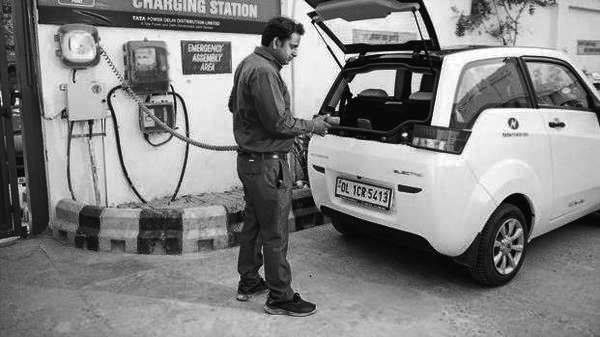Satish Singh
Adoption of eco-friendly vehicles, or electric vehicles, is the need of the hour, because the problem of pollution is increasing by the day. The use of e-vehicles will reduce pollution, and the dependence of the country on petroleum imports. Not just that, it will also help our country reduce trade deficit.
NITI Aayog has formulated an e-vehicle policy, according to which 100 per cent of e-vehicles will be sold in the country by 2030. The government has also announced subsidies to purchase e-buses, e-taxis and e-three-wheelers, as these vehicles are used in public transport. The subsidy will be given under the Fame India scheme of the Ministry of Heavy Industries. The subsidy, though, will not be given for e-vehicles purchased for personal use.
The Goods and Services Tax (GST) Council has reduced GST on e-vehicles from 12 per cent to 5 per cent. The GST Council has also reduced GST from 18 per cent to 5 per cent on e-vehicle chargers. In the first round, infrastructure for e-vehicles will be developed in cities such as Delhi, Ahmedabad, Bangalore, Jaipur, Mumbai, Lucknow, Hyderabad, Indore, Kolkata, Jammu and Guwahati.
Based on the 2011 census, it is proposed to develop basic facilities for battery charging in cities with population above 10 lakh. Initially, the aim is to establish 1,000 charging stations across India. India currently has 20 vehicles per 1,000 people, which shows that there is a huge shortage of vehicles in the country. From this perspective, there are immense possibilities of development of e-vehicles market in the country.
At present, e-vehicles comprise only 1 per cent of the total number of vehicles in the world. Therefore, it is not easy to ensure 100 per cent e-vehicle sales by 2030
EVs operates on batteries instead of petrol or diesel. Therefore, fast charging stations are essential in remote areas. Besides, there is also a need to ensure parking spots across the country and the availability of standby batteries. At present, small cars account for 75 per cent of four-wheelers on roads. The government has to electrify these cars. For keeping e-vehicles affordable, the government has to manufacture e-vehicles and its parts in India. If the government does this, only then will their price be more affordable to all. Currently, lithium ion batteries, sodium ion batteries and silicon-based batteries are being used in EVs that are quite expensive. Among these, solid lithium ion battery is currently more popular.
Mahindra and Mahindra has started assembling e-vehicle batteries for which it has invested $700 million. India’s automobile companies have joined hands with global auto companies to implement the scheme to sell 100 per cent of e-vehicles by 2030. Suzuki is to sign an agreement for the manufacture of e-vehicles with Toyota. Mahindra is to sign an agreement with Ford, while Renault will enter a pact with Nissan. Honda, Mercedes-Benz, BMW, Volvo and JLR are also among the companies working on the strategy of e-vehicle production.
At present, e-vehicles comprise only 1 per cent of the total number of vehicles in the world. Therefore, it is not easy to ensure 100 per cent e-vehicle sales by 2030. At present, the manufacturing of passenger vehicles is growing at 8 per cent per annum. Even if only e-vehicles are built in the country, 100 per cent of e-vehicles cannot be sold by 2030.
The lack of electricity can become the biggest obstacle in the path of e-vehicles adoption. Therefore, to give an e-vehicle plan an integral form, 100 per cent electricity supply across the country must be assured. Even today, 90 per cent of the electricity in the country is produced from coal. Here, the e-vehicle is not completely pollution-free.
According to experts, the manufacture of e-vehicles also leads to carbon dioxide emissions. For example, we manufacture batteries for e-vehicles using electricity. Most of this is produced using coal. We also use electricity to recharge batteries. If we add total CO2 emissions from the manufacture of batteries, including recharging and the emission of CO2, it would be less than 30 to 40 per cent, compared with conventional vehicles.
Mahindra and Ola have jointly run more than a hundred e-vehicles in Nagpur; but they are facing charging and other battery-related problems. They also have to face problems in charging batteries of e-vehicles at the time of need.
It can be said that there are many obstacles in the way of realizing the dream of e-vehicle. The biggest obstacle is the lack of infrastructure. There is a need to set up charging stations across the country to operate the e-vehicle. It is also essential to arrange for 24X7 power supply all over the country. The problem is also about the high cost of the e-vehicles. Till e-vehicles do not become affordable, common people will not be able to buy these. e-Vehicles are currently priced heavily as batteries are costly. It can come down only if these are manufactured in India.
It is obvious that e-vehicle companies and the government will need huge capital to make this dream come true. However, all these issues have not been discussed in the e-vehicle policy of NITI Aayog, owing to which the future of e-vehicles in India did not appear bright. According to Bloomberg, by 2030 only 6 per cent of all vehicle usage in India will be of e-vehicles.
The writer is Chief Manager, State Bank of India’s Economic Research Department, Mumbai, and writes on finance and banking.






































